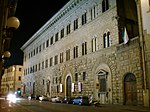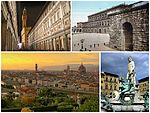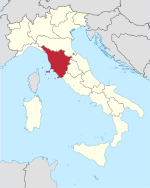Tuscany ( TUSK-ə-nee; Italian: Toscana [tosˈkaːna]) is a region in central Italy with an area of about 23,000 square kilometres (8,900 square miles) and a population of about 3.8 million inhabitants. The regional capital is Florence (Firenze).
Tuscany is known for its landscapes, history, artistic legacy, and its influence on high culture. It is regarded as the birthplace of the Italian Renaissance and of the foundations of the Italian language. The prestige established by the Tuscan dialect's use in literature by Dante Alighieri, Petrarch, Giovanni Boccaccio, Niccolò Machiavelli and Francesco Guicciardini led to its subsequent elaboration as the language of culture throughout Italy. It has been home to many figures influential in the history of art and science, and contains well-known museums such as the Uffizi and the Palazzo Pitti. Tuscany is also known for its wines, including Chianti, Vino Nobile di Montepulciano, Morellino di Scansano, Brunello di Montalcino and white Vernaccia di San Gimignano. Having a strong linguistic and cultural identity, it is sometimes considered "a nation within a nation".Tuscany is the second most popular Italian region for travellers in Italy, after Veneto. The main tourist spots are Florence, Castiglione della Pescaia, Pisa, San Gimignano, Lucca, Grosseto and Siena. The town of Castiglione della Pescaia is the most visited seaside destination in the region, with seaside tourism accounting for approximately 40% of tourist arrivals. The Maremma region, Siena, Lucca, the Chianti region, Versilia and Val d'Orcia are also internationally renowned and particularly popular spots among travellers.
Eight Tuscan localities have been designated World Heritage Sites: the historic Centre of Florence (1982); the Cathedral square of Pisa (1987); the historical centre of San Gimignano (1990); the historical centre of Siena (1995); the historical centre of Pienza (1996); the Val d'Orcia (2004), the Medici Villas and Gardens (2013), and Montecatini Terme as part of the Great Spa Towns of Europe (2021). Tuscany has over 120 protected nature reserves, making Tuscany and its capital Florence popular tourist destinations. In 2018, Florence alone had over 5 million arrivals, making it the world's 51st most visited city.











